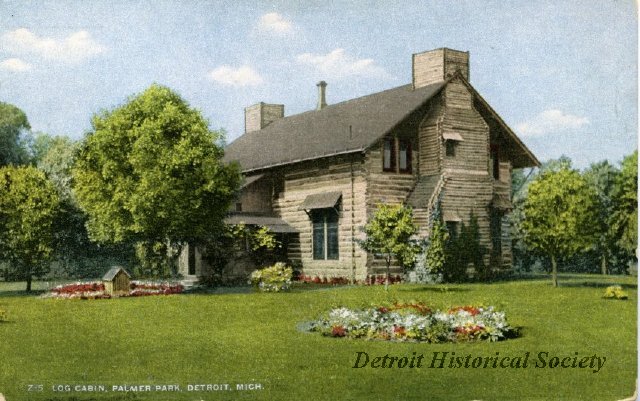Encyclopedia Of Detroit
Palmer Park Log Cabin
Tucked off of Woodward Avenue just north of McNichols Road, is Palmer Park Log Cabin. Perched on the edge of manmade Lake Frances, bordered by virgin forest on one side, and Palmer Park’s Art Deco apartments on the other, the cabin was the summer home of U.S. Senator Thomas Witherell Palmer and his wife Elizabeth, or Lizzie, Merrill.
Considered countryside, miles from the downtown center when the cabin was built in 1885, the land surrounding the cabin was part of an estate inherited from Palmer’s grandfather, Judge James Witherell, a Supreme Court judge for the Territory of Michigan. Prior to building the cabin, Palmer used the land for farming and to raise Percheron horses.
As a present to his wife, and as an escape from the hot confines of the city in the summer, Palmer hired architects George Mason and Zachariah Rice (of famed architectural firm Mason & Rice) to work with Lizzie in the design of an old-fashioned cabin. The two-story, 2,400 square foot home was finished in 1887. Rustic on the outside with oak logs using timber from the surrounding woods, inside the cabin was fully modern for its time, with plastered walls, and planked floors of walnut and white maple. Two brick fireplaces graced the north and south sides of the building and a carved oak staircase led to the second floor.
The vacation retreat was filled with family heirlooms and relics from the past such as Judge Witherell’s 1787 grandfather clock, various stuffed animals, a flintlock pistol displayed over a mantel and other items of farm life. Palmer had foliage and rocks brought in from his ancestral family homestead in Connecticut to landscape the cabin grounds, which included a small lake.
The Palmers held parties ranging from intimate gatherings to large banquets. Guests at these events often included Senator Palmer’s political colleagues and wealthy friends, as well as local farmers and small-business owners. Guests would be given a tour of the log cabin for a look at the priceless family heirlooms, followed by a meal outside in the park. Thomas Palmer found solace in bonfires, and they were a fixture at these gatherings. He once said, “I wonder if a man ever gets too old to enjoy a bonfire – I'm sure I shall never grow too old for this sort of enjoyment.”
In 1893, Thomas made the first of several donations of land to the City of Detroit, giving 140 acres surrounding the cabin for the creation of Log Cabin Park. Palmer stipulated in the donation that neither the log cabin nor forest ever be destroyed. He then authorized in 1895 that the log cabin would be turned over to the city upon his death and that of his wife, and in 1897 the land was renamed Palmer Park in honor of its benefactor.
Sometime prior to 1900, a small lighthouse was constructed near the lake, and rowing boats were rented to park visitors. The Merrill Fountain, built in 1901 in Campus Martius at the bequest of Lizzie Merrill Palmer, was moved to Palmer Park in 1925.
In 2016, the City of Detroit began work to restore and stabilize the cabin which had suffered from vandals and weather after it closed to the public in 1979. Artifacts from the cabin were donated to the Detroit Historical Society. A new cedar shingle roof, new cement foundation and a general building clean-up were part of the $400,000 effort to rehabilitate the historic building. The stained glass windows were also restored. The non-profit organization People for Palmer Park, continues to raise money for the cabin and each year holds a Log Cabin Day in June for visitors to tour the cabin and learn about its past.



